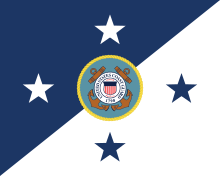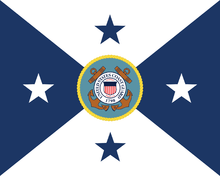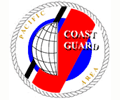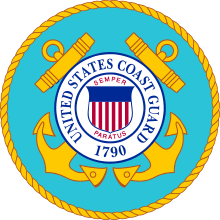Organization of the United States Coast Guard
This article covers the organization of the United States Coast Guard.
The headquarters of the Coast Guard is located at 2703 Martin Luther King Jr Avenue SE in Washington, D.C.. The Coast Guard relocated to the grounds of the former St. Elizabeths Hospital[1] in 2013.
Flag officers[2]
Admiral

The Commandant of the Coast Guard is the Coast Guard's most senior officer, who, by law, holds the rank of admiral. The commandant is selected for a four-year term, which may be renewed for additional four-year periods. The current incumbent is Admiral Karl L. Schultz, who replaced Admiral Paul F. Zukunft on June 1, 2018.[3]

The Vice Commandant of the Coast Guard is Admiral Charles W. Ray, who replaced Admiral Charles D. Michel on May 24, 2018.[4]
Vice admiral


The Deputy Commandant for Mission Support is Vice Admiral Michael F. McAllister.[5]
Vice Admiral Marshall B. Lytle III is the Director Command, Control, Communications and Computers (C4) / Cyber, Chief INformation Officer, Joint Staff, J6/CIO.[6]
The Commander of the Atlantic Area is Vice Admiral Scott Buschman.[7]
The Commander of the Pacific Area Vice Admiral Fred M. Midgette.[8]
Rear admiral
There are approximately 38 rear admirals in the Coast Guard. Positions held by rear admirals include the commanders of each of the nine Coast Guard Districts, the nine assistant commandants, and the deputies to each of the vice admirals. They are also located at Coast Guard Headquarters, Department of Defense commands, and other Coast Guard commands.[9]
The Superintendent of the United States Coast Guard Academy is Rear Admiral James E. Rendon.[10]
The Coast Guard also utilizes members of the civilian Senior Executive Service (SES) to serve as executives within the organization. There are approximately 16 SES officials in the Coast Guard.
Commodore
The rank of commodore is no longer used in the Coast Guard. The equivalent rank used today is rear admiral (lower half). The chief elected officers of the Coast Guard Auxiliary are referred to as commodores, signifying their senior elected office, rather than a military rank.
The title of commodore is occasionally granted to senior officers (typically of pay grade O-6, which is a captain) who are placed in command of a group or squadron of cutters. It is not a flag rank, but rather a title used to signify command of multiple units afloat.
Senior officers
Captain
Coast Guard captains, like their Navy counterparts, rank immediately below rear admiral (lower half). Coast Guard captains command most large operational units—sectors, large cutters, large air stations, integrated support commands, training centers and large headquarters units. Captains also direct most headquarters, area and district staff elements. Most captains have served in the Coast Guard for 21 to 30 years.
By maritime tradition, the commanding officer of a ship is also called "captain", regardless of actual rank held. Thus, a young junior officer commanding a patrol boat is properly called "captain" even if his or her actual rank is lieutenant, or lieutenant (junior grade). This tradition has also carried over to many shore units. Occasionally, terms like "old man" and "skipper" are also used, though not usually in the presence of the "captain". However, in current usage, the person in charge of a Coast Guard or Coast Guard Auxiliary small boat is the "coxswain" (pronounced cok-sun).
Commander
Coast Guard commanders (Pay grade O-5) may head departments in large operational units or staff positions, or they may be the commanding officer of a medium-sized unit. The term commander is also associated with specific commanding officer positions, such as sector commander (usually a captain) or district commander (usually a rear admiral).
Junior officers
The other commissioned officer ranks are (from most senior to least senior)
- Lieutenant commander: Examples of positions held by a lieutenant commander include command of some Coast Guard cutters, executive officers of larger cutters, or departmental oversight positions at Coast Guard Sector commands.
- Lieutenant: Examples of positions held by a lieutenant include command of small boat stations, command of Coast Guard patrol boats, and as operations officers or engineering officers aboard larger Coast Guard cutters.
- Lieutenant junior grade: Examples of positions held by a lieutenant junior grade include command of Coast Guard patrol boats, executive officers of patrol boats, small boat stations, or as assistant operations officers aboard larger Coast Guard cutters.
- Ensign. Examples of positions held by an ensign include training billets as deck watch officers aboard large cutters, student engineers aboard large cutters, and staff positions at Coast Guard Sector commands.
Chief warrant officers
The Coast Guard has three ranks of chief warrant officers. Chief warrant officers are warranted officers and are promoted from senior enlisted ranks. The ranks of warrant officer (WO1) and chief warrant officer 5 (CWO5) are not used in the Coast Guard. The three ranks in use are (from most senior to least senior):
- Chief warrant officer 4
- Chief warrant officer 3
- Chief warrant officer 2
An example of a position held by a chief warrant officer is commanding officer of a small cutter, such as USCGC Abbie Burgess.[11]
A chief warrant officer is not addressed as "chief"; that title that is normally reserved for the enlisted rank of chief petty officer (E-7). The proper way to address a chief warrant officer is to refer to their title (CWO, CWO3) or to address them as "Mr." or "Ms."
Chief petty officers
As in the Navy, Coast Guardsmen in the rates of Chief Petty Officer (E-7), Senior Chief Petty Officer (E-8), and Master Chief Petty Officer (E-9), are collectively called "chiefs," and serve as the service's senior non-commissioned officers. Due to the small and decentralized nature of the service, Coast Guard chiefs often fill roles that would normally be filled by commissioned officers in other branches. Chiefs may serve as officers-in-charge of Coast Guard Stations, command or serve as engineering petty officers on smaller cutters, and act as department heads on larger cutters.
The Master Chief Petty Officer of the Coast Guard (MCPOCG) is the senior enlisted person of the Coast Guard and serves as an advisor to the Commandant. Like the Commandant, the MCPOCG serves a four-year term.
Regional responsibilities
.png)
The Coast Guard is divided into two area commands, the Atlantic Area and the Pacific Area, each of which is commanded by a vice admiral, with each being designated Maritime Homeland Defense Areas. Each includes various district commands.[12]
The Coast Guard Atlantic Area includes five district commands covering the Eastern United States, the Atlantic Ocean, the Great Lakes, and the Gulf of Mexico. Its office is located in Portsmouth, Virginia.[13]
The Coast Guard Pacific Area includes four district commands covering the Western United States and the Pacific Ocean. Its office is located at Coast Guard Island in Alameda, California.[14]
The Coast Guard is further organized into nine districts, commanded by a District Commander, a rear admiral, with each responsible for a portion of the nation's coastline.
There are three major operational commands located outside the United States:
- USCG Activities Far East (FEACT) is located at Yokota Air Base, Japan. FEACT inspects U.S. ships overseas and foreign ships that will be operating in the U.S.[15]
- USCG Activities Europe (ACTEUR) is located in Schinnen, The Netherlands.[16]
- Patrol Forces Southwest Asia (PATFORSWA) is based out of Manama, Bahrain. Established in 2002, the mission of PATFORSWA is to train, organize, equip, support and deploy combat-ready Coast Guard forces in support of CENTCOM and national security objectives.[17]
| District | Area | District Office | Area of Responsibility |
|---|---|---|---|
| First District | Atlantic | Boston, Massachusetts | New England states, eastern New York, and northern New Jersey |
| Fifth District | Atlantic | Portsmouth, Virginia | Pennsylvania, southern New Jersey, Delaware, Maryland, Virginia, and North Carolina |
| Seventh District | Atlantic | Miami, Florida | South Carolina, Georgia, eastern Florida, Puerto Rico, and the U.S. Virgin Islands |
| Eighth District | Atlantic | New Orleans, Louisiana | Western Rivers of the U.S. and the Gulf of Mexico |
| Ninth District | Atlantic | Cleveland, Ohio | Great Lakes |
| Eleventh District | Pacific | Alameda, California | California, Arizona, Nevada, and Utah |
| Thirteenth District | Pacific | Seattle, Washington | Oregon, Washington, Idaho and Montana |
| Fourteenth District | Pacific | Honolulu, Hawaii | Hawaii and Pacific territories |
| Seventeenth District | Pacific | Juneau, Alaska | Alaska |
Coast Guard Sectors
Within each District, large operational shore-side units known as Sectors are responsible for mission execution within their area of responsibility. Sectors were formed when "groups" were merged with what were formerly known as Marine Safety Offices. Coast Guard small boat stations are called Stations and report to Sectors. Each Sector Commander reports to the appropriate District Commander.
Coast Guard Air Stations
Coast Guard Air Stations provide aviation support for other Coast Guard activities. Unlike small boat stations, air stations are not subordinate to Sector commanders. Instead the commanding officer of a Coast Guard Air Station reports to the appropriate District Commander.
Staff elements
_seal_of_the_United_States_Coast_Guard.jpg)
On July 23, 2007, the Coast Guard instituted a consolidated acquisition directorate, which handles major systems and future equipment acquisitions. It is the second largest staff element at Coast Guard headquarters. Rear Admiral Gary T. Blore, Assistant Commandant for Acquisition, leads the directorate.
The directorate’s programs include all platforms and mission systems designed to modernize and recapitalize the Coast Guard’s fleet of cutters, boats, aircraft, and information technology assets. Under the new organization, these programs are consolidated from the legacy Coast Guard acquisitions directorate and the Integrated Deepwater System Program. The new directorate also brings together the office of procurement management; the office of research, development and technical management; the Research and Development Center; and the head of contracting.[18]
Other
The Curatorial Services Office (CG-92) is located in Forestville, Maryland which includes the U.S. Coast Guard Exhibit Center.[19]
References
- ↑ http://www.uscgproject.com/
- ↑ http://www.uscg.mil/flag/ Flag Officer & Senior Executive Service Member Bios.
- ↑ "PHOTO RELEASE: New US Coast Guard commandant takes helm". U.S. Coast Guard. Retrieved 2018-06-24.
- ↑ "U.S. Coast Guard welcomes new vice commandant". Compass. Retrieved 2018-06-24.
- ↑ "Vice Admiral Michael F. McAllister > United States Coast Guard > Display". www.uscg.mil. Retrieved 2018-06-24.
- ↑ "Vice Admiral Marshall B. Lytle III > United States Coast Guard > Display". www.uscg.mil. Retrieved 2018-06-24.
- ↑ "Vice Admiral Scott Buschman > United States Coast Guard > Display". www.uscg.mil. Retrieved 2018-06-24.
- ↑ "Vice Admiral Fred M. Midgette > United States Coast Guard > Display". www.uscg.mil. Retrieved 2018-06-24.
- ↑
- ↑ "Superintendent's Biography". USCG Academy Superintendent's Biography. US Coast Guard Academy. Retrieved 18 July 2015.
- ↑ Cornish, Caroline. "Coast Guard Cutter Changes Command". WCSH-TV, Maine. http://www.wcsh6.com/news/article.aspx?storyid=67328, accessed 7-31-07
- ↑ "How many Coast Guard Districts are there?". United States Coast Guard. Retrieved 1 December 2012.
- ↑ USCG: Atlantic Area - Commander Coast Guard Atlantic Area
- ↑ USCG Flag Officer & SES Members
- ↑ Dubee, Bryce S. "Change of command comes for Coast Guard." Stars and Stripes, Pacific Edition. July 22, 2007. http://www.estripes.com/article.asp?section=104&article=55112&archive=true, accessed 7-23-2007.
- ↑
- ↑
- ↑ US Coast Guard Press Release. "Coast Guard establishes new acquisition directorate". July 23, 2007. http://www.emilitary.org/article.php?aid=11744, accessed 7-23-2007.
- ↑ www.uscg.mil Curatorial Services Office (CG-92). Retrieved 2010-06-25.
